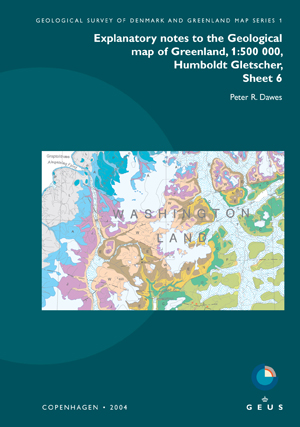Explanatory notes to the Geological map of Greenland, 1:500 000, Humboldt Gletscher, Sheet 6
DOI:
https://doi.org/10.34194/geusm.v1.4615Abstract
These explanatory notes cover the map region bounded by latitudes 78°N and 81°N and longitudes 56°W and 74°W, with geology shown on the land areas between Nares Strait - the seaway between Greenland and Ellesmere Island, Canada - and the Inland Ice. The bedrock geology is composed of Precambrian and Lower Palaeozoic provinces that continue across Nares Strait into Canada. Map units and mineral occurrences are described in general terms and are proceeded by sections on physical environment, logistics, data sources and geoscientific research. The notes are aimed at the practical user and a guide for further reading.
The bedrock is composed of three provinces separated by unconformities, each representing a hiatus of c. 500 Ma during which basic dykes were emplaced. The Palaeoproterozoic Inglefield mobile belt, forming the crystalline shield, is an E-W-trending belt of deposition and orogeny characterised by polyphase magmatism, deformation and high-grade metamorphism. Clastic deposition, with magmatism at c. 1985 Ma, are the oldest events recorded, followed by the accumulation of the Etah Group (carbonate, pelitic and psammitic sediments with supposedly coeval mafic and ultramafic rocks) between 1980 and 1950 Ma ago. These rocks were intruded 1950 to 1915 Ma ago by the Etah meta-igneous complex, that records polyphase plutonism (intermediate to felsic, with some basic and magnetite-rich rocks), followed by deformation and partial melting producing granites 1785 to 1740 Ma ago. The Mesoproterozoic Thule Basin, defined by the unmetamorphosed and little deformed Thule Supergroup, records sedimentation and basaltic volcanism at least as old as 1270 Ma. The faulted, north-eastern basin margin shown on the map preserves the passage from the basinal sequence to a relatively thin platform succession invaded by basic sills. The Palaeozoic Franklinian Basin is represented by a homoclinal Cambrian to Silurian shelf carbonate succession and a major Silurian reef complex, with coeval siliciclastic slope deposits. The map region includes the classical area for Franklinian stratigraphy, now composed of 29 formations and four groups - Ryder Gletscher, Morris Bugt, Washington Land and Peary Land Groups. The only younger units preserved in the map region are widespread Quaternary deposits, an isolated outcrop of coarse-grained fluvial deposits (Bjørnehiet Formation) and non-carbonised wood erratics of Neogene age.
Five mineral occurrence types are shown on the map: in lithologies of the Inglefield mobile belt, sulphide-graphite rust zones, a magnetite deposit and copper-gold mineralisation and in the Franklinian Basin, commercially drilled, zinc-lead-silver and zinc-lead-barium mineralisations. The basic ingredients of a petroleum model exist in the Franklinian Basin but prospectivity is low.
Published
Issue
Section
License
Copyright (c) 2004 Peter R. Dawes

This work is licensed under a Creative Commons Attribution 4.0 International License.
This article is distributed under a CC-BY 4.0 licence, permitting free redistribution and reproduction for any purpose, even commercial, provided proper citation of the original work. Author(s) retain copyright over the article contents.


